Defenses for Fall 2022
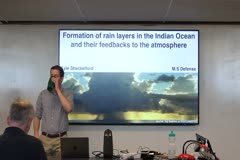
Formation of rain layers in the Indian Ocean and their feedbacks to atmospheric convection
December 05, 2022
Kyle Shackelford
Rainfall over the tropical warm pool spanning the Indian and West Pacific Oceans is relatively colder, fresher, and less dense than the near-surface ocean. Thus, under low-to-moderate winds, rainfall can act to stably stratify the upper ocean, forming a rain layer (RL). RLs cool and freshen the ocean surface and shoal ocean mixed layer depth, confining air-sea interaction to a thin,…
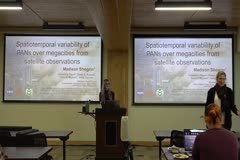
Spatiotemporal variability of peroxy acyl nitrates (PANs) over megacities from satellite observations
December 05, 2022
Madison Shogrin
Peroxy acyl nitrates (PANs) are photochemical pollutants with implications for health and atmospheric oxidation capacity. PANs are formed via the oxidation of non-methane volatile organic compounds (NMVOCs) in the presence of nitrogen oxide radicals (NOx = NO + NO2). PANs serve as reservoir species and sources for NOx in outflow regions of megacities, facilitating O3 production downwind. While…
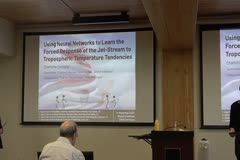
Using Neural Networks to Learn the Forced Response of the Jet-Stream to Tropospheric Temperature Tendencies
November 14, 2022
Charlotte Connolly
Two distinct features of anthropogenic climate change, warming in the tropical upper troposphere and warming at the Arctic surface, have competing effects on the midlatitude jet-stream’s latitudinal position, often referred to as a “tug-of-war”. Many previous studies have investigated the strength of the jet response to these thermal forcings, as well as many others, and have shown that…
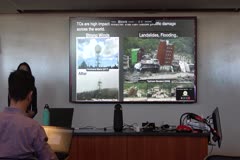
Investigation of the dynamics of tropical cyclone precipitation structure using radar observations and numerical modeling
November 08, 2022
Ting-Yu Cha
Precipitation from tropical cyclones (TCs) produces significant damage and causes fatalities worldwide. Forecast skill of the structure of precipitation in a TC remains challenging, due in part to limited fundamental understanding of the underlying complex dynamics and limitations in our observational capability. This dissertation seeks to improve our understanding of the underlying dynamics…
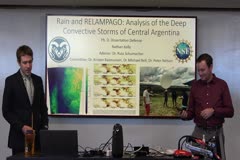
Rain and RELAMPAGO: Analysis of the Deep Convective Storms of Central Argentina
November 07, 2022
Nathan Kelly
When, where and how much precipitation falls are fundamental questions to research interests spanning the weather to climate spectrum, yet is difficult to solve. The various methods used to answer "how much" each have sources of error, making it important to obtain knowledge about the characteristics of an individual dataset. This is especially true for rare events such as extreme…
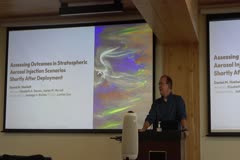
Assessing Outcomes in Stratospheric Aerosol Injection Scenarios Shortly After Deployment
October 05, 2022
Daniel Hueholt
Current global actions to reduce greenhouse gas emissions are very likely to be insufficient to meet climate targets outlined under the Paris Agreement. This motivates performing research on possible methods for intervening in the Earth system to minimize climate risk while decarbonization efforts continue. One such hypothetical climate intervention is stratospheric aerosol injection (SAI),…
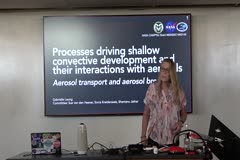
Processes driving shallow convective development and their interactions with aerosols: Aerosol transport and aerosol breezes
September 01, 2022
Gabrielle Leung
In this two-part thesis we investigate the development of tropical shallow convective clouds (i.e. shallow cumulus and cumulus congestus) and their interactions with the aerosol environment using idealized large-eddy simulations (LES). Although much about shallow convection is well-understood, we specifically focus on three facets of shallow convection that remain understudied: (1) the factors…

Application of Neural Networks to Subseasonal to Seasonal Predictability in Present and Future Climates
August 22, 2022
Kirsten Mayer
Subseasonal to seasonal timescales (S2S; 2 weeks to a season) are known for their lack of predictability. Yet accurate predictions on these timescales provide crucial, actionable lead times for agriculture, energy, and water management sectors. Fortunately, specific earth system states – deemed forecasts of opportunity – can be leveraged to improve prediction skill. Our current…
